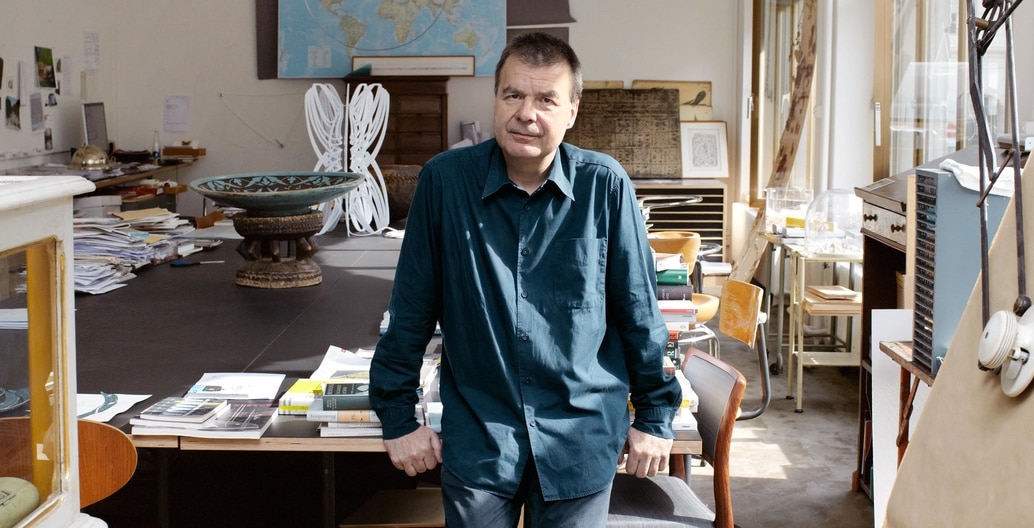
Günther Vogt and the sensory city
Zurich-based landscape architect Günther Vogt is bringing nature and consideration of intimate human experience into big urban infrastructure projects.
Foreground: You will be speaking at the upcoming Australian Institute of Landscape Architects’ International Festival of Landscape Architecture. The theme of the festival is parks and squares. What parks or squares influenced you as a child?
Günther Vogt: Since I grew up in the countryside, there was no real urban park, so the private garden was more important. My two grandmothers had really big gardens – my mother as well – so this was the most influential reception of nature or landscape that I had. If you are a little boy and you have dahlias growing in the garden with flowers as big as your head, this is a powerful first experience with nature. And of course my grandfather showed me the forests and explained things. But I will never go back to the countryside! I am very happy to live in the middle of a very dense urban situation.
Zurich where I live has the best airport in Europe. An hour-and-a-half and I can get anywhere in Europe. I prefer to take the train, but it is still only four hours to Paris, three hours Milan, three hours to Munich so it’s in the middle of all these urban settings. It’s very good for me. I can live this urban life and I don’t have to take care of a garden! This is really the reason you have a garden – to spend time in your garden – but I don’t have time for a garden.
Foreground: You mentioned taking the train. Do you drive in Europe? Car culture is big in Australia.
Günther Vogt: Yes, I read about it. A colleague who worked in our London office asked if I’d like to do a field trip while in Australia, and the first proposal was to fly for three or four hours. My god! I don’t fly 24 hours to come to Australia and then fly more hours. Okay, they said, then we have to go by car, but then it’s four to five hours. I really want to walk because I’m really interested in this European culture of walking, especially the English culture – Richard Long, Hamish Fulton. So, for instance, from Zurich I can take a train and in two hours I’m walking on a glacier. This is by public transport. And in the evening I’m back. In between I have lunch. And this is all public transport and walking. And that’s my culture. In the end I really relate to walking and the walker’s perspective.
Foreground: In your projects, have you had to fight for pedestrians over cars?
Günther Vogt: Yes, but in Europe currently the real problems are the cyclists. So, for instance in London, within two years they’ve built six main access routes only for bikes. Cycling or electro-cycling is all over Europe. Everybody demands it. The conflict in Europe is now about pedestrians and cyclists rather than pedestrians and cars. We got rid of the cars in the city. And I think these are some old recipes here because in the sixties we did this change in the cities for cars and now we are doing it for bikes. And you have increasing conflicts. In Switzerland public transport is intense. Where I grew up, public transport was always the most important thing. I can imagine that’s completely different to Australia or America or other parts of Europe.
Foreground: Tell me about your contribution to the book Entwurfsdinge – Collecting as a Tool of Modern Architecture.
Günther Vogt: The author collected the responses of various architects – and, in my case, a landscape architect – to the question: how do you use your collection for designing? My way is very simple. Girls and boys have a Sunday walk, and families always collect leaves or stones and take them home like treasure. In my case it was the same. I started when I was nine years old but with a very high level of botany as I had joined a society.
Claude Levi-Strauss, the French philosopher, explains that there are two ways to design. One is bricolage – people collecting things or just using what is on the table, at hand, and then arrange that into something. And this is bottom-up designing. And the engineer is top-down. In the office we decide depending on the project: are we bricolage or are we engineer? Those kind of people that collect and arrange things – when you ask them why they collect, they say “Ah, well you never know!” So collecting can be either bottom-up or top-down. When I start a project I sometimes ask my colleagues: can you choose one of the objects of the Wunderkammer and put it on the table? So people all bring one piece. And then we discuss why they bring this piece, and this is to start a discussion about what is our first approach or priority or attitude to a new project. It can really be helpful. Then there’s more top-down work, but it starts with bottom-up.
Foreground: Are these pieces from your own collection – your cabinet of curiosities – that you keep in the office?
Günther Vogt: Yes, and it’s quite large! I was asked when the book was presented in Berlin whether there’s a problem with space. It’s always a problem of space. But never ask a collector if he has enough space! He will always find somewhere to store it or rearrange a collection. I use it for teaching as well. I ask my students to do a walk through the Wunderkammer. For instance from where I’m sitting I see a coconut – I bought it in a supermarket – and then I have a coco de mer, the biggest seed in the world, and underneath there is an artwork by a young Swiss artist of a coconut from Bikini Island and it’s radioactive and is a completely different shape. I use it to have discussions with the students and it’s an easy way to get a good discussion going.
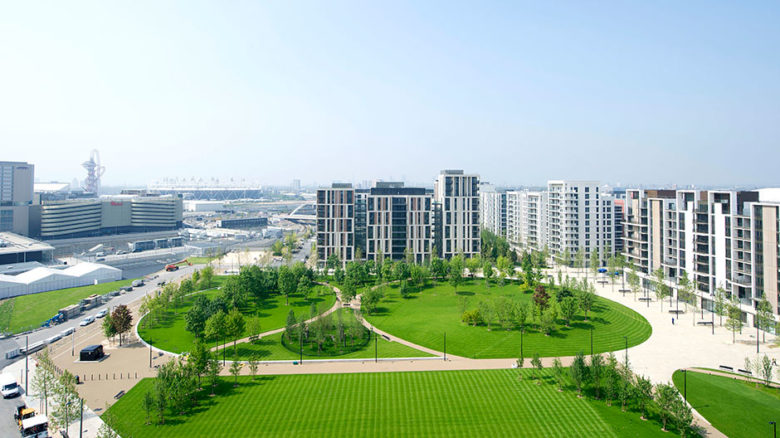
Athlete's Village, London. After the 2012 Olympics it will become a residential community with retail, office and educational facilities. Photo: @VOGT
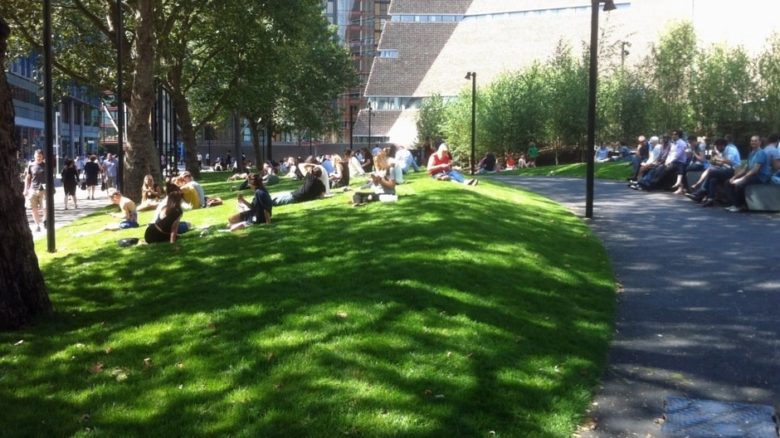
Tate Modern River Work. "But people in England, they need grass! They want to sit on grass. Even really elegant ladies in their mid-seventies, they have a basket and half-an-hour after rain, they are sitting on the grass!" Photo: @VOGT
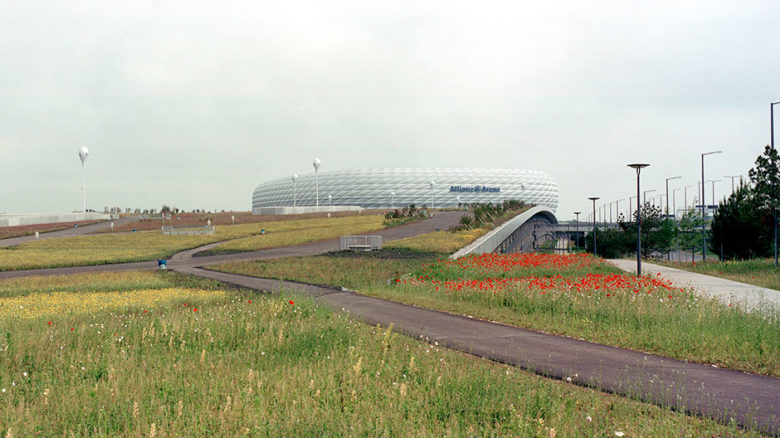
Allianz Arena, Munich. This hybrid combination landscape-park is not only a platform for the stadium building but also a reassessment of today’s definition of a park. Photo: Christian Vogt
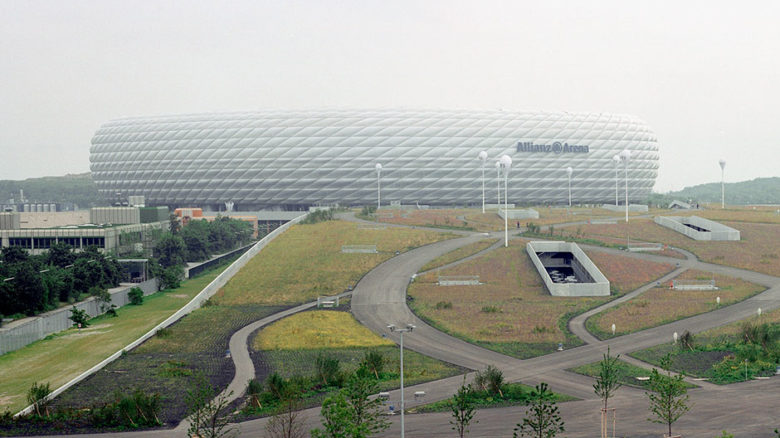
Allianz Arena, Munich where the building and the landscape architecture are mutually dependent. Photo: Christian Vogt
Foreground: This leads nicely to a question about how you conduct research within the office or with your students. Many design practices now have a research arm. How has your idea of research evolved?
Günther Vogt: Our research is more search and research I would say. One important tool is the field trip. For instance, we did one this year and the discussion that came up was about the literal production of landscape. By accident I saw something in southern England. On the bus I thought, oh what kind of landscape is this? There was a landscape producing lawn. You cut it up and roll it. So we went to see more and do a little research. And then we always look at what is around. We found beautiful historic houses and a garden by Derek Jarman. There is a nuclear power station nearby, and from the First World War huge concrete buildings like land art that were used to hear the German planes – soldiers stood in the middle and it was like a huge ear. But the real interest was the production of ‘landscape’ – the production of lawn. It’s industrial production.
As well as documenting what is found, other important research is about having good information in advance. For example we did this with Scarpa’s cemetery, partly to decide first how to prepare to document the visit. What is best: black and white photo? Sketching? Then there is another type of research we do which we call logbook, like you keep on a ship. This is a documentation for other colleagues. It’s a problem that in offices you lose knowledge. The documentation afterwards is a bit of work but it’s always useful for new people coming into the office.
Foreground: Is each field trip a distinct exploration? Do they happen regularly?
Günther Vogt: Yes. I’m definitely not interested in sports, but in the end it’s really about this body-related experience and I see it especially with my students. Sometimes they are skaters or some such, but if not, they often don’t have any body-related experience with landscape. Last semester we were in a Swiss landscape and we found out that it’s very well connected to the airport. So they did a huge investment for skiing and so on. But in September the same landscape is used by people from the Middle East who come to see it rain. A rainy landscape for us is a bit sad but for them to see and experience rain is a great event. So understanding this body experience is very important.
Foreground: Have you only done field trips within Europe?
Günther Vogt: No. This is more my personal project – how can I explain it? – I read a text about plant hunters. Mainly English and French plant hunters, and mainly in China but also Australia and the US as well. When you read their descriptions and the list of plants, it looks like our countryside garden, but they describe it as wilderness. It’s very strange to read it. What I do is not really a field trip but closer to an expedition. In northern India and the Himalayas up to 5000 metres you still have trees and I wanted to see this landscape where our garden plants are coming from. It is wilderness, but when I have my scientific brain on it’s just a garden. I am interested in history and to see the moods and origins of European gardens.
Foreground: Are you suggesting that now we are so familiar with some species – particularly, for example, rhododendrons that now grow in Britain wild – that we can go to a wilderness and see it as a garden because the plants are familiar?
Günther Vogt: Well, yes. Of course, you need a guide in India and you walk up for seven hours and you can feel there are bears and leopards perhaps around you or that it is somehow dangerous. It’s not wilderness aesthetically but it is a real wilderness.
Foreground: Why did you set up a practice in London?
Günther Vogt: In the past we were constantly asked to do projects and we did it from Zurich. But we got to the point where, with the Olympic Village and parallel projects, there was a lot of work there. I have to say I really like this English approach – it took me two years to understand it! In the beginning, in front of such a famous gallery as the Tate Modern, I started with this European, or even Mediterranean, understanding of public space. But people in England, they need grass! They want to sit on grass. They don’t need benches. Even really elegant ladies in their mid-seventies, they have a basket and half-an-hour after rain, they are sitting on the grass! They have an erotic relationship with grass! We did these little winding forests out of birch and they are very popular – but not in a grid or a line! In the middle of such a metropolitan situation of millions of people, they want to see landscape. And I think, by the way, this is the future for landscape architecture.
“This is interesting for me: aside from climate change, what is the cultural change?” – Günther Vogt
Foreground: Could you tell us more about different attitudes to parks in different countries that you have experienced?
Günther Vogt: I think the rest of Europe – especially the south – is really interested in more mineral spaces. For a lecture in Milan they asked me for a poster with a message. They asked: “What does fragile landscape mean for you?” I had no idea at first. Then I did a poster of Paris showing the medieval town, very narrow streets, it’s like a city as a labyrinth. And then added a cutting, the nineteenth century axis into the city that destroyed more than 20,000 houses to establish this huge bourgeois promenade, although it was more to get access for the military. And then I added a third layer, a green axis – not trees, because you have to bring fresh air into the centre of Paris and this is through meadows because trees would block the wind. And the reason for all this was that last summer, between five and six thousand elderly people died in Paris because of the heat. They died because of climate change. So we will have to react to this. We need extreme solutions, like really building such green axes for fresh air and cooling. They still believe in this kind of hard mineral plazas, but after the last two summers we’ve had, everybody’s asking for trees and shade. It’s really a cultural change. This is interesting for me: aside from climate change, what is the cultural change? In Italy it is difficult because the plaza is where you meet people, to have a coffee in the sun, and it has to be wide and generous and so on. But they have to change this.
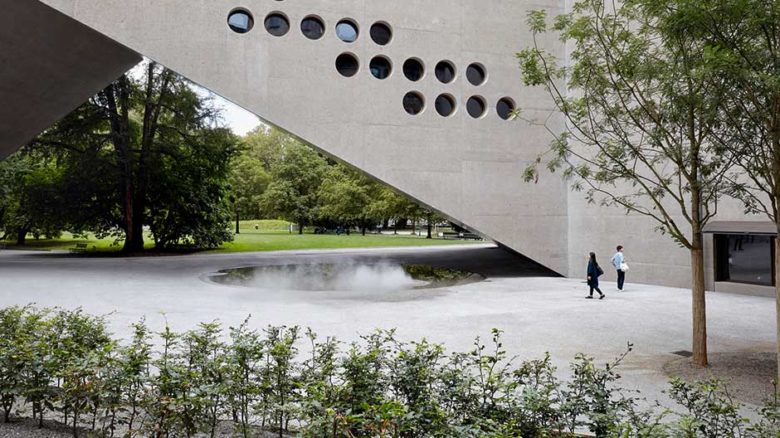
Swiss National Museum, Zurich. Vogt's practice used a few striking elements to establish visual relations between the Gartenhof and Park. Photo: Giuseppe Micciche
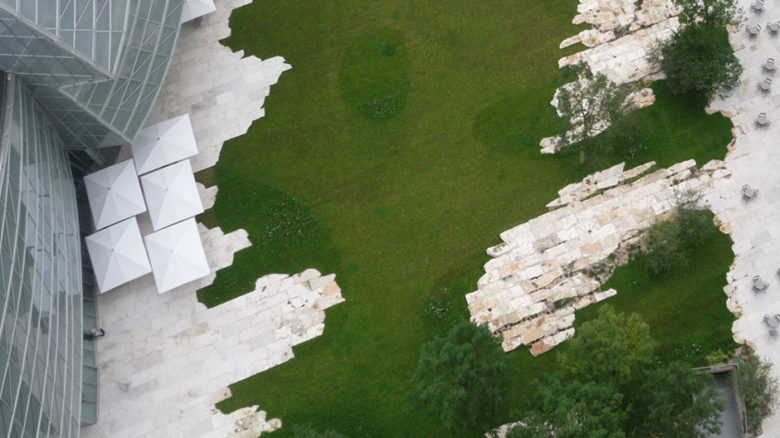
The Green, Novartis Campus, Basel, is a hybrid of square and park designed as an entree for the surrounding buildings and meeting place for the campus. Photo: @VOGT
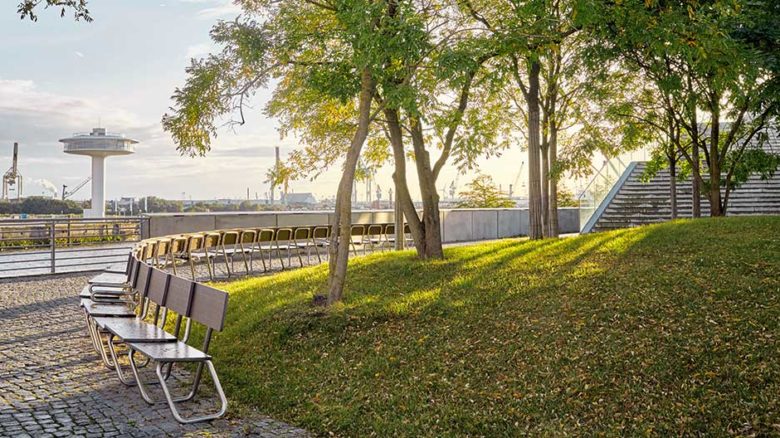
Lohsepark, Hamburg, creates a visual connection from water to water and a clear spatial differentiation over three levels: the city level, the park level and the historic level. Photo: Giuseppe Micciche
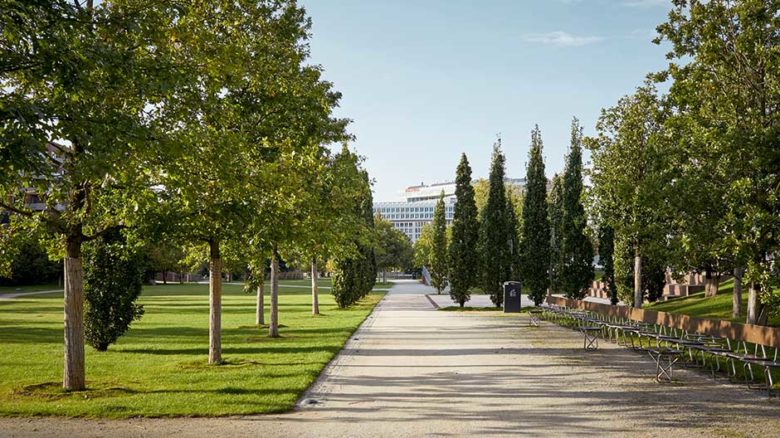
Lohsepark, Hamburg. On both ends the long axis of the open space opens up towards water: the river Elbe and the old harbor canals. Photo: Giuseppe Micciche
Foreground: Have you seen indications that there is interest in changing? Is there incentive to redesign open space to respond to climate change?
Günther Vogt: Yes, especially this competition we won with OMA in Milan. There were two huge sites. When I read the brief and saw that the first site was to be 100 percent public space, the second, 60 percent public space, and the rest 40 percent and 30 percent green, I couldn’t believe it. I wondered why do they even need an architect? That was a very interesting discussion. I’m not a depressive person but in Milan they have problems with the air and with water. Forty kilometres away in Switzerland the water is perfect and clean, but when it gets to Milan it is so contaminated. So is the soil. Everything is a disaster.
That’s one aspect. The other was that they had bad experiences with traditional urban design competitions. The decisions always considered the shape of the building, with a famous architect doing a high-rise, with this shape and that shape. But the real problem in the end was the public space. So then they decided to start with the public space and the landscape. We are currently working in a similar scale on a competition in Hamburg with the same approach, yet quite different process. The team is separated. The landscape architects and the planners and architects are separated in the first phase. They want to know what each would do and then bring it together in the second phase. It’s a bit complicated and it’s not so easy to work in the beginning but it is very interesting!
Foreground: You have offered a definition of public space as somewhere you should be able to get a free drink of water.
Günther Vogt: Zurich is a city of public fountains. We have hundreds of public fountains and really good, fresh water. But you don’t have it everywhere in Europe. Even in Switzerland there are discussions about whether to build a new dam, produce power and so on. But the future is that we will have to build many dams in the Alps to keep fresh water back because already in some parts – and Switzerland is the chateau d’eau, the castle of water for Europe – people don’t have enough drinking water. The glaciers are melting or no longer there, so we will need dams. We are working on a project to freeze water for storage without using energy. It’s very easy: we take water from a river and 200 metres below you have pressure so you can use a pipe to sprinkle it up where it freezes. Then you have a frozen volume and, of course, in summertime it’s melting but you have for three or four months this water on hold. And we found out with a glaciologist, that if we do it in the middle of a glacier – on a grand scale – then a glacier could grow again. The idea is coming from Ladakh, India where they had this problem and didn’t have enough water at the right times, so they stored it as ice without using energy. But it is a huge infrastructure in a beautiful landscape. It’s all, in the end related to landscape, but landscape architectural education is often not related to these large-scale interventions. This is a problem for me. I did see it in Harvard, but of course you have big landscape infrastructure in the US. In Europe this isn’t even a topic, but it is coming.
–
Günther Vogt’s first visit to Australia will be as keynote speaker for the 2019 Australian Institute of Landscape Architects’ International Festival of Landscape Architecture. Click here for tickets.


